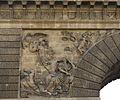Porte Saint-Martin (Paris)
The Porte Saint-Martin , like the Porte Saint-Denis, is a 17th century triumphal arch on the Grands Boulevards (great boulevards) in Paris . It is located in the 10th arrondissement , at the intersection of Rue Saint-Martin , Rue du Faubourg Saint-Martin, Boulevard Saint-Martin and Boulevard Saint-Denis . The nearest metro stations are Strasbourg - Saint-Denis on lines 4 , 8 and 9 . In 1862 the building was included in the list of French architectural monuments as Monument historique .
history
Around 1670, the Grands Boulevards were laid out on the site of the city wall built under Charles V in the 14th century . Today's Porte Saint-Martin was built 60 meters north of the former city gate, which was also called Porte Saint-Martin, in the shape of an ancient triumphal arch. The city of Paris dedicated these to King Louis XIV in 1674 in memory of his victories in Franche-Comté during the Dutch War .
The architect of the Porte Saint-Martin was Pierre Bullet , a student of François Blondel , who built the Porte Saint-Denis, built in 1672 and located 200 meters away.
architecture
The triumphal arch is 18 meters high and just as wide. It is built from large, regularly hewn limestone blocks with clearly marked joints. A large round arched arcade opens in the middle , the two side passages are half the size.
The north and south sides are provided with reliefs . The left relief on the north side, created by Gaspard Marsy, depicts the defeat of the Habsburgs . Louis XIV, in the form of Mars, the god of war, chases away an eagle and holds a shield decorated with three lilies in his hand. The right relief is by Pierre Le Gros . A sad female figure next to a lion lying on the ground symbolizes the conquest of Limburg .
The reliefs on the south side represent the capture of Besançon and the break of the alliance of the countries allied against France. They were created by Martin Van den Bogaert called Desjardins (right) and Étienne Lehongre (left). On the left, Louis XIV is depicted as Hercules with a club and a lion's skin , who is crowned with a laurel wreath by Victoria, the goddess of victory . On the left, a kneeling woman hands the keys of the city of Besançon to the Sun King.
The Latin inscription is carved on the south side of the marble-clad attic : LUDOVICO MAGNO VESONTIONE SEQUANISQUE BIS CAPTIS ET FRACTIS GERMANORUM HISPABORUM BATAVORUMQUE EXERCITIBUS. PRAEF. ET AEDIL. PCC ANN. RSH MDCLXXIV (Louis the Great, who twice conquered Besançon and the Sequaner territory and defeated the Germanic, Hispanic and Batavian armies, from the Prévôt des marchands and the lay judges of Paris in 1674).
The north side bears the inscription: LUDDOVICO MAGNO QUOD LIMBURGO CAPTO IMPOTENTES HOSTIUM MINAS UBIQUE REPRESSIT. PRAEF. ET AEDIL. PCC ANN. RSH MDCLXXV (Louis the Great, who after the capture of Limburg everywhere rejected the threats of the impotent enemies, from the Prévôt des marchands and the lay judges of Paris in 1675).
literature
- Jean Colson, Marie-Christine Lauroa (ed.): Dictionnaire des Monuments de Paris . Éditions Hervas, Paris 2003 (1st edition 1992), ISBN 2-84334-001-2 , pp. 715-716.
Web links
- Porte Saint-Martin in the Base Mérimée of the French Ministry of Culture (French)
Coordinates: 48 ° 52 '8.9 " N , 2 ° 21' 20.3" E





